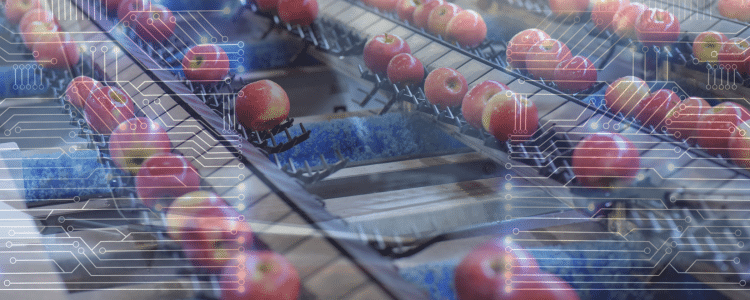The Industrial Internet of Things (IIoT) is a technology that connects sensors, equipment, and software throughout manufacturing plants. Organizations can quickly see the real-time status of production machines and make informed decisions on what actions to take.
The food and beverage (F&B) industry, in particular, stands to realize many benefits from IIoT implementation. When it comes to IIoT in the food and beverage industry, companies can improve uptime and increase machine reliability.
Today, we’re looking at what’s happening with IIoT in this sector.
Optimizing Machine Reliability
To keep up with customer demand and meet strict requirements around safety and compliance, F&B businesses must have access to reliable machines.
With IIoT, it’s easier for F&B leaders to analyze and report on machine health. Condition monitoring sensors allow them to clearly see where issues are currently happening, and where they might occur in the future. This allows them to optimize operations and prevent costly downtime.
Software Selection & Process Improvement Case Study
In helping the client get its project back on track, one of our primary focus areas was decreasing their customization needs by improving their processes to align with the system's best practices.
Reducing Waste
When operations are more streamlined and efficient, they’re also less wasteful.
This is a concern of particular importance to the F&B industry, as there’s a substantial amount of food waste created during the production process. Throughout food processing plants, waste commonly occurs when food must be altered to be prepared for consumption.
For instance, when machines pare and scrape edible parts such as skins, peels, and crusts, those items are not always saved or reused.
Other common sources of food waste include:
- Leaks
- Overproduction
- Product rejects
- Product losses
- Defective machinery
When companies are more attuned to the condition of their machines, they can make adjustments to limit waste.
Machine data also makes it easier to calculate the exact quantities and kinds of resources consumed, including energy and water. Companies can use these insights to curb waste and improve operational efficiency.
Optimizing Maintenance
Throughout the F&B industry, labor shortages have made it difficult to find skilled, qualified talent in the maintenance and engineering departments. This is another reason companies are embracing IIoT solutions as part of their digital transformation.
With these connected tools, maintenance actions become more intentional and better informed. Technicians only have to work on machines, when necessary, rather than on a routine basis. This allows F&B maintenance staff to do the following:
- Focus on more mission-critical issues
- Lower the risk of unplanned downtime
- Lower the risk of unexpected machine breakdowns
How to Evaluate IIoT Applications
Increasingly, F&B manufacturers are using integrated IIoT solutions to manage rotating equipment, such as bottling lines and conveyor systems.
These IIoT tools include sensors, gateways, and software that collect and analyze data. Companies can use this to monitor their plants’ health around the clock.
While some components are pre-built with factory-provided sensors, this isn’t the only option. There are also aftermarket sensors that teams can retrofit onto their existing equipment. This can help lower the cost of IIoT adoption and make it easier for F&B leaders to explore these solutions.
For companies just starting this journey, it might make sense to start small and build from there. Begin by adding just a few IIoT applications to your workflows, focusing on your biggest pain points.
For example, you might start by implementing an on-site data monitoring solution that allows you to view plant operations. Then, you can expand your IIoT footprint as you connect to various points throughout your facilities.
Aggregating Assets
While it’s helpful to outfit F&B equipment with digitally connected sensors, all of those insights must be combined into a comprehensive view to be useful.
That’s where manufacturing ERP software comes in.
With ERP software or SCM software, organizations can view all of their operational and financial information in a single system. Within this system, they can also visualize all of their assets in the form of digital twins.
A digital twin mimics the layout and function of a given facility in an online format. Take the layout of a food processing plant, for instance. Most plants consist of multiple processing lines that include various conveyors and different types of handling equipment. Organizations can implement a predictive performance system that allows users to upload a schematic of the facility, creating a digital view of production lines.
As long as there are sensors attached to the various parts of each conveyor (e.g., motors, bearings, gearboxes), authorized plant personnel can watch each line in action. They’ll also receive instant alerts if the equipment is compromised in any way, such as being exposed to too much heat or vibration.
What to do With All this Data
When a manufacturing company uses IoT or IIoT to collect data, they usually don’t have the capacity to analyze all of it or glean all of the possible insights.
Artificial intelligence (AI) can be useful in this respect. Many manufacturers are starting to use AI to analyze large volumes of internal and external data.
One use case is leveraging prescriptive analytics to . . .
- Analyze production data
- Consider external factors
- Provide supply chain optimization recommendations
(Learn more about AI in the food and beverage industry.)
Data Transfer and Security Concerns
Once real-time sensor data is captured, it may need to travel beyond the F&B facility. This can raise concerns about how to safeguard such information across the in-plant IT network.
While sophisticated technologies can utilize security solutions, such as air-gapped technology and cellular gateways, there are also simpler routes. In some instances, companies can retrofit their existing IIoT products with internal intelligence monitors. This allows them to identify and react to security threats as soon as they arise.
Learn More About IIoT in the Food and Beverage Industry
As F&B companies look for ways to improve their operations, they’re turning to IIoT solutions. These interconnected systems are enabling them to keep a close eye on their assets and operations.
If you’re wanting to learn more about the role of IIoT in the food and beverage industry, schedule a free consultation with our enterprise software consultants.














